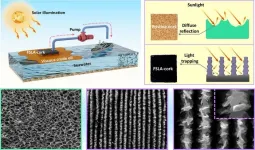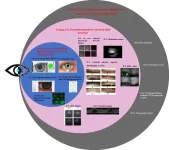(Press-News.org) WASHINGTON, April 23, 2024 – Oil spills are deadly disasters for ocean ecosystems. They can have lasting impacts on fish and marine mammals for decades and wreak havoc on coastal forests, coral reefs, and the surrounding land. Chemical dispersants are often used to break down oil, but they often increase toxicity in the process.
In Applied Physics Letters, by AIP Publishing, researchers from Central South University, Huazhong University of Science and Technology, and Ben-Gurion University of the Negev used laser treatments to transform ordinary cork into a powerful tool for treating oil spills.
They wanted to create a nontoxic, effective oil cleanup solution using materials with a low carbon footprint, but their decision to try cork resulted from a surprising discovery.
“In a different laser experiment, we accidentally found that the wettability of the cork processed using a laser changed significantly, gaining superhydrophobic (water-repelling) and superoleophilic (oil-attracting) properties,” author Yuchun He said. “After appropriately adjusting the processing parameters, the surface of the cork became very dark, which made us realize that it might be an excellent material for photothermal conversion.”
“Combining these results with the eco-friendly, recyclable advantages of cork, we thought of using it for marine oil spill cleanup,” author Kai Yin said. “To our knowledge, no one else has tried using cork for cleaning up marine oil spills.”
Cork comes from the bark of cork oak trees, which can live for hundreds of years. These trees can be harvested about every seven years, making cork a renewable material. When the bark is removed, the trees amplify their biological activity to replace it and increase their carbon storage, so harvesting cork helps mitigate carbon emissions.
The authors tested variations of a fast-pulsing laser treatment to achieve the optimal balance of characteristics in the cork that can be achieved at low cost. They closely examined nanoscopic structural changes and measured the ratio of oxygen and carbon in the material, changes in the angles with which water and oil contact the surface, and the material’s light wave absorption, reflection, and emission across the spectrum to determine its durability after multiple cycles of warming and cooling.
The photothermal properties endowed in cork through this laser processing allow the cork to warm quickly in the sun. The deep grooves also increase the surface area exposed to sunlight, so the cork can be warmed by just a little sunlight in 10-15 seconds. This energy is used to heat up spilled oil, lowering its viscosity and making it easier to collect. In experiments, the laser-treated cork collected oil out of water within 2 minutes.
The laser treatments not only help to better absorb oil, but also work to keep water out.
“When the cork undergoes a fast-pulsing laser treatment, its surface microstructure becomes rougher,” Yin said. “This micro- to nano-level roughness enhances hydrophobicity.”
As a result, the cork collects the oil without absorbing water, so the oil can be extracted from the cork and possibly even reused.
“Oil recovery is a complex and systematic task, and participating in oil recovery throughout its entire life cycle is our goal,” Yuchun He said. “The next step is to prepare electrothermal materials using polyurethane foam as the skeleton for oil adsorption, combining photothermal and electrothermal techniques to form an all-weather oil recovery system.”
###
The article “Femtosecond laser structured black superhydrophobic cork for efficient solar-driven cleanup of crude oil” is authored by Yuchun He, Kai Yin, Lingxiao Wang, Tingni Wu, Yu Chen, and Christopher J. Arnusch. It will appear in Applied Physics Letters on April 23, 2024 (DOI: 10.1063/5.0199291). After that date, it can be accessed at https://doi.org/10.1063/5.0199291.
ABOUT THE JOURNAL
Applied Physics Letters features rapid reports on significant discoveries in applied physics. The journal covers new experimental and theoretical research on applications of physics phenomena related to all branches of science, engineering, and modern technology. See https://aip.scitation.org/journal/apl.
###
END
Laser-treated cork absorbs oil for carbon-neutral ocean cleanup
Treated cork has higher absorbance, harnesses sunlight to trap oil in minutes.
2024-04-23
ELSE PRESS RELEASES FROM THIS DATE:
COVID-19 vaccination and incidence of pediatric SARS-CoV-2 infection and hospitalization
2024-04-23
About The Study: The findings of this study including 3.9 million children suggest that vaccination against SARS-CoV-2 was associated with significant reductions in COVID-19 incidence and hospitalizations among children in California.
Authors: Justin V. Remais, Ph.D., of the University of California, Berkeley, is the corresponding author.
To access the embargoed study: Visit our For The Media website at this link https://media.jamanetwork.com/
(doi:10.1001/jamanetworkopen.2024.7822)
Editor’s Note: Please see the article for additional information, including other authors, author contributions and affiliations, conflict of interest and ...
Long-term taste and smell outcomes after COVID-19
2024-04-23
About The Study: Taste dysfunction as measured objectively was absent one year after exposure to COVID-19 while some smell loss remained in nearly one-third of individuals with this exposure, likely explaining taste complaints of many individuals with post–COVID-19 condition in this study of 340 individuals with and 434 individuals without prior COVID-19. Infection with earlier untyped and Alpha variants was associated with the greatest degree of smell loss.
Authors: Shima T. Moein, M.D., Ph.D., of the University of Pennsylvania ...
Artificial intelligence to be used for the detection of common eye disease
2024-04-23
Dry Eye Disease (DED) is one of the more common eye diseases, affecting up to 30% of the world’s population. This disease can affect many different types of people and can wind up being a great hindrance to their overall quality of life. Early screening and prognosis is vital to the patient’s progression with the disease. However, this can be difficult. In this study, researchers aim to use artificial intelligence (AI) to aid in early screening and prognosis of DED. Not only can the use of AI make screening more accessible for ...
A roadmap for digital neuroscience
2024-04-23
Neuroscience has entered a new, digital phase. The combination of brain research with supercomputing in large-scale, multi-disciplinary research collaborations has enabled an innovative approach to deciphering the brain, using powerful scientific technologies and data ressources. These developments open up new possibilities for brain research, medicine and technology. A position paper by over 100 authors, now published in the journal Imaging Neuroscience, summarises the current status and identifies ...
Radiologists propose actions to combat climate change
2024-04-23
OAK BROOK, Ill. – A diverse writing group—lead by authors at the University of Toronto—have developed an approach for radiology departments and practices to reduce their greenhouse gas emissions and become more resilient to the effects of climate change. They outlined their action plan in a Radiology in Focus article, published today in Radiology, a journal of the Radiological Society of North America (RSNA).
“Rising greenhouse gas emission levels lead to climate change, extreme weather events and worsening air pollution with downstream adverse health effects,” said lead author Kate Hanneman, M.D., M.P.H., vice chair of research ...
SwRI to discuss connected vehicle data exchanges, AI tools at 2024 ITS America Conference & Expo
2024-04-23
SAN ANTONIO — April 23, 2024 — During this week’s ITS America Conference & Expo, Southwest Research Institute will share its latest intelligent transportation systems (ITS) research designed to integrate connected vehicle data exchanges and artificial intelligence into public transportation infrastructure.
“SwRI’s ITS solutions are designed to improve safety for the traveling public using software that helps transportation agencies operate more efficiently,” said Josh Johnson, ...
Announcing the second cohort of the Hevolution/AFAR new investigator awardees in aging biology and geroscience research
2024-04-23
New York, NY —The American Federation for Aging Research (AFAR) is pleased to announce the second cohort of the Hevolution/AFAR New Investigator Awards in Aging Biology and Geroscience Research, a grant program to enable early-career investigators with labs in the US and Canada to advance research projects in basic biology of aging, as well as geroscience projects that translate advances in basic research on aging biology from the laboratory to the clinic, paving the way for healthspan-expanding therapeutics and treatments. ...
Advances in understanding the evolution of stomach loss in agastric fishes
2024-04-23
Living beings can evolve to lose biological structures due to potential survival benefits from such losses. For example, certain groups of ray-finned fishes show such regressive evolution—medakas, minnows, puffera, and wrasses do not have a stomach in the gastrointestinal tract, making them agastric or stomachless fishes. However, the specific evolutionary mechanisms underlying the evolution of agastric fishes remains unclear.
Studies about Slc26a9—a molecular transporter highly expressed in the stomach of many species—in fishes provided the initial clue. Researchers ...
Social media affects people’s views on mental illness
2024-04-23
COLUMBUS, Ohio – Even subtle differences in the wording of social media messages may be enough to sway young people’s beliefs about depression and anxiety and their treatment.
In a new study, researchers found that college students were more optimistic about the possibility of successfully treating mental health problems after they read social media messages conveying what is called a “growth mindset.”
But social media posts written with a “fixed mindset” led young people to feel that depression and anxiety were more stable and innate, and not so easy to treat.
Growth mindset is the belief that a feature, such ...
Aerogel-based PCMs improve thermal management, reduce microwave emissions in electronic devices
2024-04-23
Electronic devices are getting more and more complex as they are built to carry out an ever-increasing number of functions. This can be seen in the increased functionality in our personal devices such as our phones, tablets and watches, let alone in industrial devices. However, their growing complexity can lead to performance and safety issues. These issues include device overheating or emitting microwaves that can result in health issues and that can reduce a device’s performance and interfere with other devices.
Chinese scientists from Beijing Normal University have been ...
LAST 30 PRESS RELEASES:
Injectable breast ‘implant’ offers alternative to traditional surgeries
Neuroscientists devise formulas to measure multilingualism
New prostate cancer trial seeks to reduce toxicity without sacrificing efficacy
Geometry shapes life
A CRISPR screen reveals many previously unrecognized genes required for brain development and a new neurodevelopmental disorder
Hot flush treatment has anti-breast cancer activity, study finds
Securing AI systems against growing cybersecurity threats
Longest observation of an active solar region
Why nail-biting, procrastination and other self-sabotaging behaviors are rooted in survival instincts
Regional variations in mechanical properties of porcine leptomeninges
Artificial empathy in therapy and healthcare: advancements in interpersonal interaction technologies
Why some brains switch gears more efficiently than others
UVA’s Jundong Li wins ICDM’S 2025 Tao Li Award for data mining, machine learning
UVA’s low-power, high-performance computer power player Mircea Stan earns National Academy of Inventors fellowship
Not playing by the rules: USU researcher explores filamentous algae dynamics in rivers
Do our body clocks influence our risk of dementia?
Anthropologists offer new evidence of bipedalism in long-debated fossil discovery
Safer receipt paper from wood
Dosage-sensitive genes suggest no whole-genome duplications in ancestral angiosperm
First ancient human herpesvirus genomes document their deep history with humans
Why Some Bacteria Survive Antibiotics and How to Stop Them - New study reveals that bacteria can survive antibiotic treatment through two fundamentally different “shutdown modes”
UCLA study links scar healing to dangerous placenta condition
CHANGE-seq-BE finds off-target changes in the genome from base editors
The Journal of Nuclear Medicine Ahead-of-Print Tip Sheet: January 2, 2026
Delayed or absent first dose of measles, mumps, and rubella vaccination
Trends in US preterm birth rates by household income and race and ethnicity
Study identifies potential biomarker linked to progression and brain inflammation in multiple sclerosis
Many mothers in Norway do not show up for postnatal check-ups
Researchers want to find out why quick clay is so unstable
Superradiant spins show teamwork at the quantum scale
[Press-News.org] Laser-treated cork absorbs oil for carbon-neutral ocean cleanupTreated cork has higher absorbance, harnesses sunlight to trap oil in minutes.








